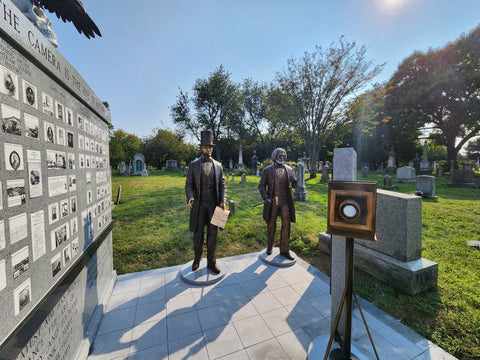
Mathew Brady Was a Genius. His New Monument Lives Up To That Reputation
On September 17, 2022, Historic Congressional Cemetery dedicated The Mathew Brady Memorial, near the famed photographer’s final resting place in the cemetery. The memorial, spearheaded by historian Larry West, celebrates Brady’s work as a photographer, but also reflects the diversity of his subjects and the Washington community. The memorial includes life-sized bronze statues of President Abraham Lincoln and Frederick Douglass, along with a life-sized porcelain photo of Mathew Brady and a bronze replica of his camera.This year, 2022, marks the 200th anniversary of Mathew Brady’s birthday. Brady might fairly be called the father of American war photography.
Although his exact birthday is unknown, Brady is estimated to have been born between 1822 and 1824. This year marks a starting point for recollecting the 200th anniversary of his birth.
Born to Irish immigrants in New York, Brady experienced a meteoric rise in fame thanks to his skill at producing daguerreotype photography, the first publicly accessible form of photography, which was then in high demand. Acclaimed for his remarkably crisp and striking style of photography, he created portraits of many notable people.
Brady’s skills had arguably the most significant impact when applied to war photojournalism. After the Civil War broke out in 1861, Brady became determined to capture the war in photos. Rallying his staff and other photographers, Brady doggedly followed the troops. Alongside the soldiers, Brady experienced the hardships of military life and was even forced to retreat with Union troops to Washington in the wake of the First Battle of Bull Run.
The most haunting wartime images associated with Brady were taken at Antietam. Brady’s associates Alexander Gardner and James F. Gibson photographed the carnage left behind from the battle, emphasizing the bodies of dead soldiers left twisted and scattered across the lonely battlefield. Brady shocked — and deeply moved — members of the public when he chose to show these images in an exhibit called “The Dead of Antietam” in his New York gallery in 1862.Brady’s exhibition marked the first time that photographs of war dead on the battlefield were shown to the American public. This changed the way the public viewed the ongoing struggle and arguably altered their perceptions of war and its consequences.“These pictures have a terrible distinctness,” wrote a New York Times correspondent on Oct. 20, 1862. “By the aid of the magnifying-glass, the very features of the slain may be distinguished.”
A pioneer of war photojournalism, Brady died in 1896 in New York and is buried in the Congressional Cemetery in Washington, D.C. The National Archives has digitized over 6,000 images taken by Brady and his staff during the Civil War, which continue to provide vivid glimpses into the history of war and conflict.
Abraham
Lincoln (Library of Congress)
Mathew Brady's
backmark. (Library of Congress)
Ambrose Burnside, with his distinctive mutton chops, caught
reading the paper. (National Archives)
Walt Whitman (National Archives)
Frederick Douglas (Library of
Congress)
Clara Barton
(National Archives)
Ulysses S. Grant (Library of
Congress)
Infantry
on parade. (National Archives)
Cooks at work,
captured by Brady. (National Archives)
The dead at Antietam.
(Library of Congress)
Soldiers
recovering from battle. (National Archives)
A view of
Gettysburg. (National Archives)
The battlefield of Fredericksburg. (National Archives)
Union camp scene captured by Brady. (National
Archives)
(Congressional Cemetery)
The unveiling of the Mathew Brady Memorial.
(Congressional Cemetery)
A statue of Abraham Lincoln at the Mathew Brady
Memorial. (Congressional Cemetery)
